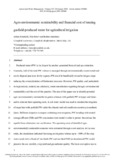JavaScript is disabled for your browser. Some features of this site may not work without it.
| dc.contributor.author | Alban, Echchelh | |
| dc.contributor.author | Hess, Tim M. | |
| dc.contributor.author | Sakrabani, Ruben | |
| dc.date.accessioned | 2019-10-31T10:48:06Z | |
| dc.date.available | 2019-10-31T10:48:06Z | |
| dc.date.issued | 2019-10-29 | |
| dc.identifier.citation | Echchelh A, Hess T, Sakrabani R. (2020) Agro-environmental sustainability and financial cost of reusing gasfield-produced water for agricultural irrigation. Agricultural Water Management, Volume 227, January 2020, Article number 105860 | en_UK |
| dc.identifier.issn | 0378-3774 | |
| dc.identifier.uri | https://doi.org/10.1016/j.agwat.2019.105860 | |
| dc.identifier.uri | http://dspace.lib.cranfield.ac.uk/handle/1826/14659 | |
| dc.description.abstract | Produced water (PW) is the largest by-product generated from oil and gas extraction. Currently, half of the total PW volume is managed through environmentally-controverted and costly disposal practices. In dry regions, PW could be beneficially reused to irrigate crops reducing the overexploitation of freshwater resources. However, PW quality, and particularly its high salinity, sodicity and alkalinity, create uncertainties regarding the agro-environmental sustainability and the cost of this practice. The aim of this paper was to identify potential agro-environmentally sustainable irrigation schemes with gasfield-PW in hyper-arid Qatar and to estimate their operating costs. A soil-water model was used to simulate the irrigation of sugar beet with gasfield-PW under the climatic and soil conditions occurring in northern Qatar. Different irrigation strategies combining over-irrigation, PW blending with treated sewage effluent (TSE) and PW desalination were tested in order to protect the soil and the aquifer from salinisation and sodification. The operating costs of identified agro-environmentally sustainable scenarios were estimated through a cost analysis. In the case study, the simulations indicated that using an irrigation volume up to ∼300% of the crop water needs with a blend of two-thirds PW and one-third TSE (or desalinated PW) could preserve the soil stability, crop yield and groundwater quality. The least-cost option was to reduce the irrigation amount at a little over the crop water needs and mix PW with an equivalent volume of TSE or four equivalent volumes of desalinated PW which would cost $0.26/m3 and $0.46/m3 respectively. As traditional PW disposal practices cost between $0.06–$16.67/m3, reusing PW in irrigation is thus potentially a competitive PW management strategy for O&G firms. | en_UK |
| dc.language.iso | en | en_UK |
| dc.publisher | Elsevier | en_UK |
| dc.rights | Attribution-NonCommercial-NoDerivatives 4.0 International | * |
| dc.rights.uri | http://creativecommons.org/licenses/by-nc-nd/4.0/ | * |
| dc.subject | arid climate | en_UK |
| dc.subject | irrigation water quality | en_UK |
| dc.subject | modelling | en_UK |
| dc.subject | sodicity | en_UK |
| dc.subject | salinity | en_UK |
| dc.subject | Qatar | en_UK |
| dc.title | Agro-environmental sustainability and financial cost of reusing gasfield-produced water for agricultural irrigation | en_UK |
| dc.type | Article | en_UK |
Files in this item
The following license files are associated with this item:
This item appears in the following Collection(s)
-
Staff publications (SWEE) [2825]

